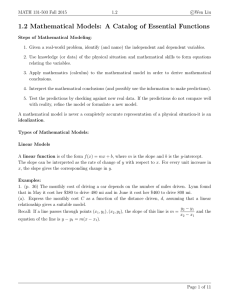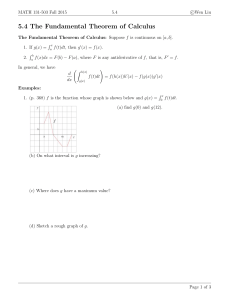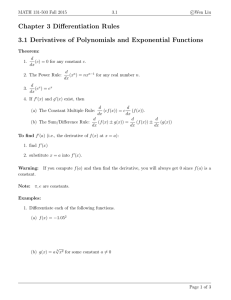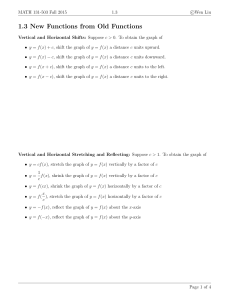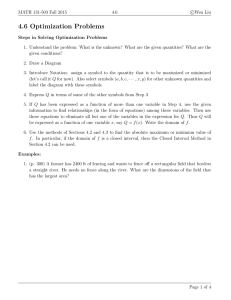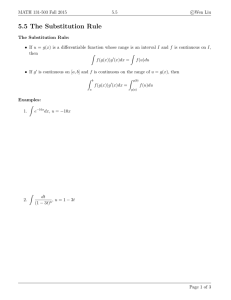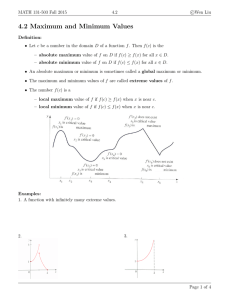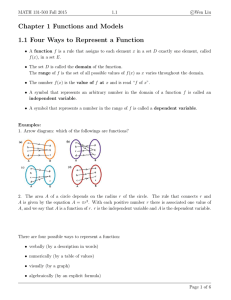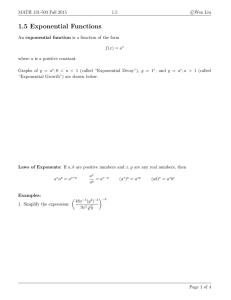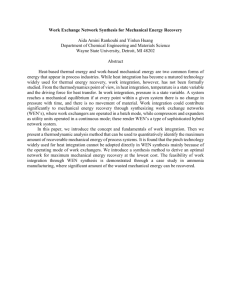Document 10435020
advertisement
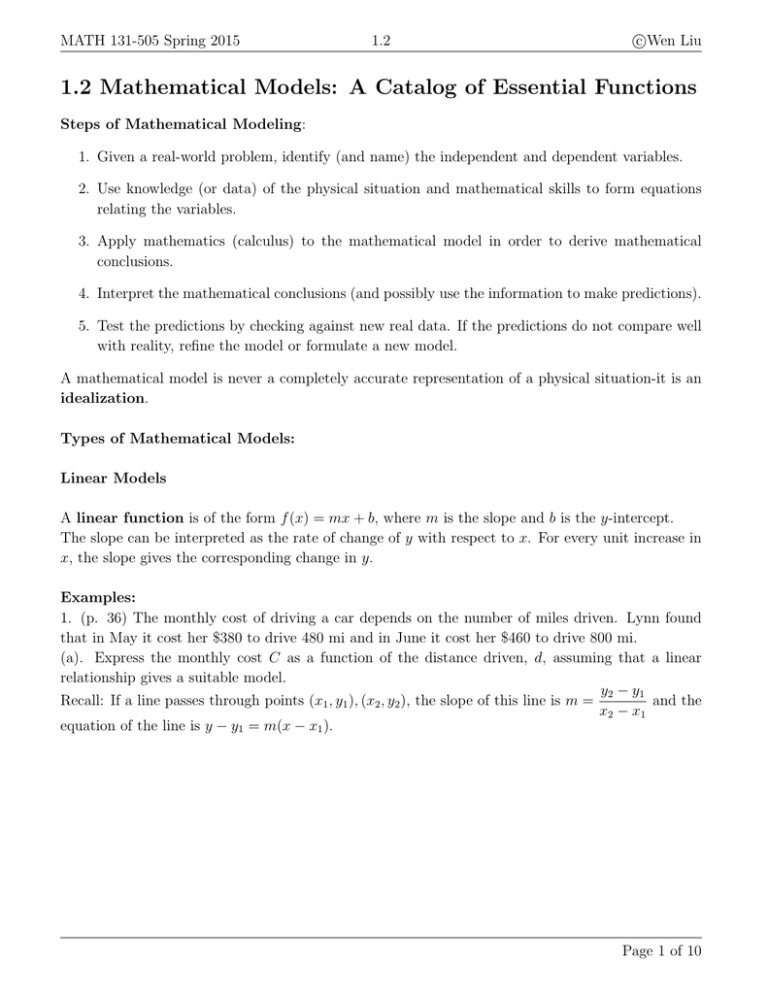
MATH 131-505 Spring 2015 1.2 c Wen Liu 1.2 Mathematical Models: A Catalog of Essential Functions Steps of Mathematical Modeling: 1. Given a real-world problem, identify (and name) the independent and dependent variables. 2. Use knowledge (or data) of the physical situation and mathematical skills to form equations relating the variables. 3. Apply mathematics (calculus) to the mathematical model in order to derive mathematical conclusions. 4. Interpret the mathematical conclusions (and possibly use the information to make predictions). 5. Test the predictions by checking against new real data. If the predictions do not compare well with reality, refine the model or formulate a new model. A mathematical model is never a completely accurate representation of a physical situation-it is an idealization. Types of Mathematical Models: Linear Models A linear function is of the form f (x) = mx + b, where m is the slope and b is the y-intercept. The slope can be interpreted as the rate of change of y with respect to x. For every unit increase in x, the slope gives the corresponding change in y. Examples: 1. (p. 36) The monthly cost of driving a car depends on the number of miles driven. Lynn found that in May it cost her $380 to drive 480 mi and in June it cost her $460 to drive 800 mi. (a). Express the monthly cost C as a function of the distance driven, d, assuming that a linear relationship gives a suitable model. y2 − y1 Recall: If a line passes through points (x1 , y1 ), (x2 , y2 ), the slope of this line is m = and the x2 − x1 equation of the line is y − y1 = m(x − x1 ). Page 1 of 10 MATH 131-505 Spring 2015 1.2 c Wen Liu (b). Use part (a) to predict the cost of driving 1500 miles per month. (c). What does the slope represent? (d). What does the C-intercept represent? 2. (p. 35) Recent studies indicate that the average surface temperature of the earth has been rising steadily. Some scientists have modeled the temperature by the linear function T = 0.02t + 8.5, where T is temperature in ◦ C and t represents years since 1900. (a) What do the slope and T -intercept represent? (b) Use the equation to predict the average global surface temperature in 2100. 3. (p. 35) Jason leaves Detroit at 2 : 00 PM and drives at a constant speed west along I-96. He passes Ann Arbor, 40 mi from Detroit, at 2 : 50 PM. (a) Express the distance traveled in terms of the time elapsed. (b) Draw the graph of equation in part (a). (c) What is the slope of this line? What does it represent? Page 2 of 10 MATH 131-505 Spring 2015 1.2 c Wen Liu Linear Regression: We can construct an empirical model based on collected data if there is no physical law or principle to help us create a model. We will find a curve (called the least squares line) that “fits” the data points best. Note: The line does NOT have to go through any of the points. Example 4: (p. 27) The table below lists the average carbon dioxide level in the atmosphere (in parts per million) at Mauna Loa Observatory from 1980 to 2002. Year 1980 1982 1984 1986 1988 1990 1992 1994 1996 1998 2000 2002 CO2 level 338.7 341.1 344.4 347.2 351.5 354.2 356.4 358.9 362.6 366.6 369.4 372.9 a. Make a scatter plot of these data and decide whether a linear model is appropriate. Scatterplot: 1) Press STAT , EDIT , 1: Edit , and enter the inputs in L1 (in our case, x values, i.e. years) and outputs in L2 (in our case, y values, i.e. CO2 level). Note: If you have data in your lists and you want to clear it, scroll up to the list name and hit CLEAR . Do not hit DELETE on the list name; the entire list will be deleted. 2) Press 2nd, Y=, and ENTER 3) Turn the Stat Plot on by highlighting “on” and pressing ENTER . For “Type”: Highlight the first graph. Be sure you have X List: L1 and Y List: L2 . (To call L1 , press 2nd, 1 .) 4) Press ZOOM , 9 to graph the data points. Note: On the Y= screen, “Plot 1” should be (highlighted). If you are not using your stat plots, make sure they are turned off (unhigh-lighted) on this screen. b. Find a linear model using the first and last data points. (Use t for time (in years) and C for the CO2 level (in ppm). Round your values to eight decimal places.) Note: Our model gives values higher than most of the actual CO2 level. A better linear model is obtained by linear regression. Page 3 of 10 MATH 131-505 Spring 2015 1.2 c Wen Liu c. Find the least squares regression line. Linear Regression: (after data has been entered using the instructions above) 1) From the home screen ( 2nd, MODE ), press STAT , CALC , and 4 . 2) On the home screen, you should see “LinReg(ax+b)”. Call L1 , L2 , Y1 and press ENTER to run. The comma is above the 7 , and to get Y1 , press VARS , Y-VARS , FUNCTION , and 1 . (This will store your model in Y1 .) 3) Press ZOOM , 9 to see the data and the model graphed. Note: When you press STAT , CALC , you will see several regression models besides linear regression. They include Quadratic, Cubic, Quartic, Exponential, Logarithmic, Logistic, and Sine models. d. Use your unrounded model (which should still be stored in your calculator) to estimate the average CO2 level for 1987 and to predict the level for 2010. Finding Function Values: 1) Enter the function in slope-intercept form into Y1 by pressing Y=. 2) On the home screen (2nd, MODE ), call Y1 by pressing VARS , Y-VARS , FUNCTION ,and 1 . Then, open parenthesis, type the input value, and close parenthesis. You should have something like Y1 (1987). Press ENTER . e. Use your unrounded model to determine during what year the CO2 level will exceed 400 ppm. Intersecting Functions (to solve equations): 1) Press Y= and enter the left side of the equation into Y1 and the right side (400) into Y2 . (Make sure your Stat Plots 1, 2, and 3 are off, i.e. unhighlighted.) 2) Try ZOOM , 6 ; ZOOM , 0 ; or WINDOW (adjust) and then GRAPH . (Remember, you must be able to see the intersection point in your window.) In our case, you may adjust the window like this: Xmin=0, Xmax=2200, Xsc1=200; Ymin=0, Ymax=500, Ysc1=100. 3) Press 2nd, TRACE , and 5 . 4) Move your cursor close to the intersection point, and press ENTER for the first curve, ENTER for the second curve, and then ENTER again for “Guess?”. The intersection is now displayed on the screen. Page 4 of 10 MATH 131-505 Spring 2015 1.2 c Wen Liu Polynomials 1. A function P is called a polynomial if P (x) = an xn + an−1 xn−1 + · · · + a2 x2 + a1 x + a0 where n is a nonnegative integer, the numbers an , an−1 , · · · , a2 , a1 , a0 are constants called the coefficients of the polynomial, and an 6= 0 is called the leading coefficient. The degree of the polynomial is n. 2. The domain of any polynomial is R = (−∞, ∞). 3. A polynomial of degree 1 is of the form P (x) = mx + b and so it is linear function. 4. A polynomial of degree 2 is of the form P (x) = ax2 +bx+c and is called a quadratic function. 5. A polynomial of degree 3 is of the form P (x) = ax3 + bx2 + cx + d and is called a cubic function. The graph of a quadratic function P (x) = ax2 + bx + c is concave up if a > 0 and concave down if a < 0. A cubic function P (x) = ax3 + bx2 + cx + d has an inflection point. Page 5 of 10 MATH 131-505 Spring 2015 c Wen Liu 1.2 Example 5: (p. 30) A ball is dropped from the upper observation deck of the CN Tower, 450 m above the ground, and its height h above the ground is recorded at 1-second intervals in the following table: Time (seconds) 0 1 2 3 Height (meters) 450 445 431 408 4 5 6 7 8 9 375 332 279 216 143 61 Find an appropriate model for the data and use the unrounded model to predict the time at which the ball hits the ground. Note: Even though a cubic function will fit the data, we should NOT consider a cubic function because there is no inflection point in the scatter plot, and we want the least “complicated” function possible. Power Functions A function of the form f (x) = xa , where a is a constant, is called a power function. We consider several cases: (i) a = n, where n is a positive integer The graphs of f (x) = xn for n = 1, 2, 3, 4, and 5 are shown below. Page 6 of 10 MATH 131-505 Spring 2015 c Wen Liu 1.2 1 , where n is a positive integer n √ The function f (x) = x1/n = n x is a root function. √ √ Graph f (x) = x and g(x) = 3 x. Find their domains and ranges. (ii) a = (iii) a = −1 The graph of the reciprocal function f (x) = x−1 = 1 is shown below. x Rational Functions A rational function f is a ratio of two polynomials: f (x) = P (x) Q(x) where P and Q are polynomials. The domain consists of all values of x such that Q(x) 6= 0. Examples: Find the domain for each of the following. 1 6. f (x) = x Page 7 of 10 MATH 131-505 Spring 2015 7. g(x) = 8. h(t) = 1.2 c Wen Liu 2x4 − x2 + 1 x2 − 4 x2 1−x − 5x + 6 Algebraic Functions A function f is called an algebraic function if it can be constructed using algebraic operations (such as addition, subtraction, multiplication, division, and taking roots) starting with polynomials. Any rational function is automatically an algebraic function. Examples of algebraic functions: f (x) = √ x2 + 1, g(x) = √ x4 − 16x2 √ + (x − 2) 3 x + 1 x+ x Trigonometric Functions Examples: Graphs the functions and find their domains and ranges. 9. f (x) = sin x 10. g(x) = cos x 11. h(x) = tan x Page 8 of 10 MATH 131-505 Spring 2015 c Wen Liu 1.2 Properties: sin(x + 2π) = sin x cos(x + 2π) = cos x tan(x + π) = tan x Exponential Functions The exponential functions are the functions of the form f (x) = ax , where the base a is a positive constant. The domain is R = (−∞, ∞) and the range is (0, ∞). Example 12: Graph y = 2x and y = 0.5x . Logarithmic Functions The logarithmic functions f (x) = loga x, where the base a is a positive constant, are the inverse functions of the exponential functions. (a) a > 1: The graph of y = loga x is the relection about the the line y = x of the graph y = ax . (b) 0 < a < 1: The graph of y = loga x is the relection about the the line y = x of the graph y = ax . (c) Graphs of some logarithm functions. In each case the domain is (0, ∞) and the range is R = (−∞, ∞). Page 9 of 10 MATH 131-505 Spring 2015 c Wen Liu 1.2 Example 13: Classify the following functions as one of the types of functions that we have discussed. (a) f (x) = π x (b)g(x) = −2.01 log1.1 x (c) h(t) = sin(5t) tan2 t (e) f (s) = (g)h = √ 7 s (d)y = 1 − 2.6x3 (f)y = 1−x √ 1+ x 2x2 6x − x5 Domain of a function. Functions x , where n is an even positive integer 1 x m , where m is an odd positive integer 1 n an xn + an−1 x 1 x n−1 + · · · + a1 x + a0 loga x Domains x≥0 x∈R x 6= 0 x∈R x>0 f (x) , where f (x) and g(x) are functions x for f (x) and g(x) are defined and g(x) 6= 0 g(x) Page 10 of 10
